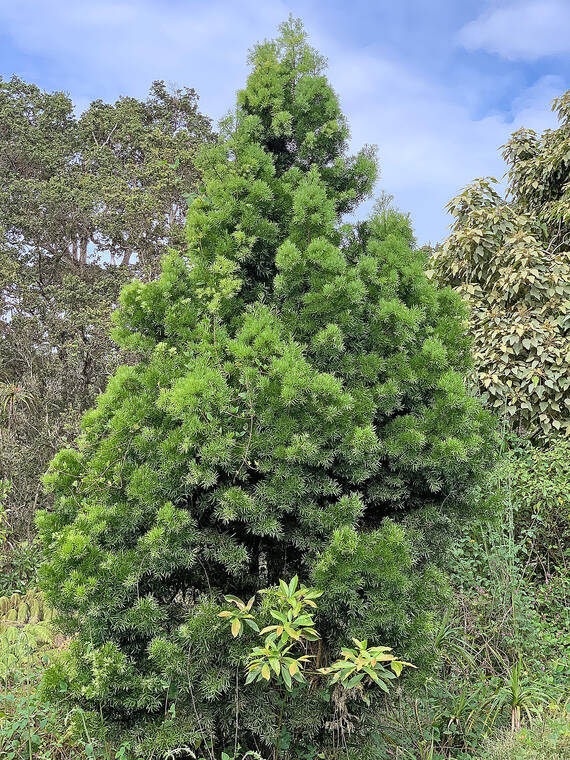In the past, Local folks often used Norfolk pine, Portuguese cypress or even Podocarpus as Christmas trees, but homegrown trees are hard to find this year. However, there are plenty of trees being shipped from the mainland — but don’t delay since trees that are shipped in early are best.
Hopefully in a few years, we may actually have locally grown Douglas ifr and other traditional mainland trees available from local farms at high elevations. Presently, researchers are testing the adaptability of these cold climate species on the up slopes of Hawaii Island. This could be a whole new farm enterprise for us since thousands of trees are imported every year.
Cut trees on the market this year are the firs, Mexican or Portuguese cypress, Monterey pine, and spruce. Each of the common types of Christmas trees available has advantages that should be weighed. However, if you wait too long, remember the trees remaining may be a bit over the hill since they were probably cut quite some time ago.
Imported trees have some additional disadvantages to consider. They tend to lose their needles quickly. And, one of the most common of the spruces, the white spruce, has a strong odor that is objectionable to some people. Firs, especially the Noble firs, have rich green coloring and they generally hold needles much better than spruce trees.
Freshness is very important in selecting a cut tree. Don’t buy any tree that has browned needles. A discolored tree is beginning to dry out. Many people wait until the last minute to buy a Christmas tree so that it will have a good appearance on Christmas Day and through the remaining holidays. Actually, just the opposite may be true. Trees held at stores or on lots may not be kept under ideal cool conditions. It is better to buy from early shipments and place the tree in a bucket of water in the garage or storeroom. It will keep better than on the lot and you will probably have a better selection if you buy early.
If you decide to cut your own tree, a few Christmas tree farms are located on our island. Monterey pines and Portuguese or Mexican cypress are fresh, attractive and have a pleasant fragrance. Selecting locally grown trees also helps keep dollars in Hawaii.
Cut trees may be kept longer if a little soluble fertilizer is added to the water in which the tree stands. Don’t overdo it or the tree will dry out even faster than if you had used no fertilizer.
Some nurseries and garden centers on island are carrying Norfolk pine, Monterey pine, Mexican cypress, spruce, and others as living Christmas trees. Some are miniatures already decorated. These may be planted in the garden in mauka areas. Fir, spruce and some pines require cold weather found above 6,000 feet. Mexican cypress and Monterey pine will do well and look best at 3,000 to 6,000 feet elevation. Araucarias like the Norfolk pine, being mostly tropical grow well below 4,000 feet. The exceptions would be with species like the Monkey Puzzle pine that come from cold climates of South America. This tree from Chile has been grown as far north as British Columbia along the West Coast.
Araucaria and Podocarpus species do not have a pine scent so if you miss the piney fragrance, check out local stores and garden shops that sell mainland pines. They will often have cut branches available at little or cost to incorporate into your Christmas scene. As a last resort, if you must have that evergreen Christmas tree smell, consider pine scented room deodorants!



